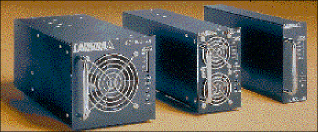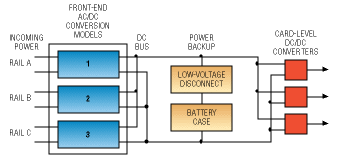What a designer
should know about
front-end power systems
Here's a look at recent trends and some tips
for specifying front-end ac/dc supplies
BY MICHAEL WAGNER
Lambda Electronics
Melville, NY
Front-end power supplies are increasingly being used to meet the needs of distributed-power architectures in tele-communications networks. The front-end power supply converts ac power to 28 Vdc (for wireless cellular) or 48 Vdc. This voltage is then converted at the card level by on-board dc/dc converters to whatever operating voltage is required–typically 5, 3.3, or 2.5 V for DSP chips.
The newest front ends are more compact and powerful, offer more flexibility for design-in, and are available at lower cost than those previously available. These improvements are making it easier to specify a front-end supply. Still, designers need to make sure the front-end system accommodates redundant operation and provides features such as battery backup and diagnostics to ensure smooth, reliable operation.
Greater flexibility
As a result of the use of smaller, high-frequency components, the newest supplies have a higher power density to allow reduced size and/or a higher power capacity. Lambda Electronics' FE series supply, for example, comes in a rack system that is 19 in. wide and 3U high, compared to previous-generation products that were up to 6U high. The supply can be configured for up to 6 kW from three sizes of power modules: 500, 1,000, or 2,000 W (see Fig. 1 ).

Fig. 1. Today's front-end supplies, such as Lambda Electronics'
FE series, typically offer a choice of power modules to allow
the user flexibility in configuring the power system.
To make implementation of front-end power supplies easier, some manufacturers offer off-the-shelf supplies fully compatible with the dc/dc converters that provide on-board distributed power. These off-the-shelf power solutions also save time and reduce risk by carrying global safety agency approvals and meeting worldwide telecom standards.
The cost of front-end power is declining as versatile standard products become widely available. A competitive price point for adequately featured front-end power systems is now less than $0.70 per watt for large quantities.
Design considerations
While front-end supplies have improved, the designer should still keep several factors in mind. For instance, to meet worldwide requirements front-end power systems should be adjustable to operate from 85 to 265 Vac at 50/60 Hz, provide power factor and harmonic correction, and carry worldwide telecom and safety approvals. Other features that enhance design flexibility include adjustable output voltages within 24- and 48-Vdc ranges and a choice of EIA (19-in.-wide) or NEBS (23-in.-wide) racks.
Most front-end systems accommodate redundant operation, so that they continue to operate should a power module malfunction. The system should also allow hot pluggability so that a new power module can be inserted into the live voltage bus without taking down the system.
To guard against failure caused by uncontrolled temperature conditions at remote sites, the power supply should withstand operating temperatures from –40° to +70°C. Other desirable features for remote-site installations include remote diagnostics, remote on and off, overvoltage and overtemperature protection, and proper output-current-limiting characteristics for battery charging and discharging.
Also, the front-end power system should have a low-voltage-disconnect (LVD) module to invoke the battery backup when an ac-fail condition exists (see Fig. 2 ). The LVD module, installed in series with the battery, functions as an intelligent switch that senses output voltages from the front-end bus.

Fig. 2. In a front-end power system, a low-voltage-disconnect module
senses output voltages from the front-end bus, switching the system to
battery power in the event of an ac power failure.
Automatic fault reset is an important feature of a front-end system equipped with a low-voltage disconnect. This allows fast power recovery at remote-site installations without requiring service personnel to manually shut the system down and power it up again.
Advertisement





